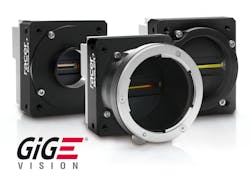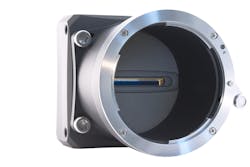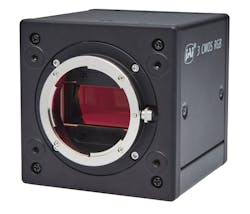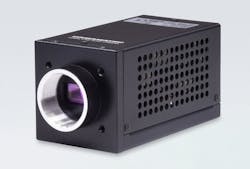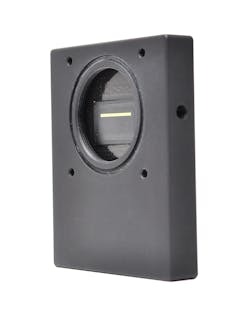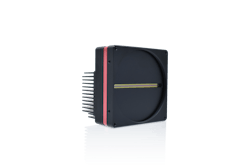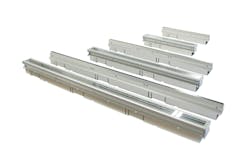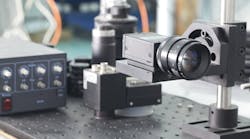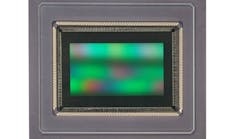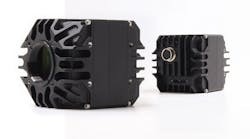Line scan cameras provide high-speed inspection of tasks such as web inspection and capturing images of larger objects. Manufacturers of line scan cameras continue advancing the technology by introducing or improving upon capabilities like faster line rates, increased resolution, and imaging beyond the visible.
Line scan cameras feature single (e.g. 2048 x 1) or multiple rows of pixels (e.g. 2048 x 2) that capture images while objects or the camera move across the field of view of the lens. Cameras covered in this article include monochrome, color, multispectral, shortwave infrared (SWIR), Time Delay Integration (TDI) and contact image sensor (CIS) technologies, providing numerous options for systems developers for finding the best fit for an application.
Monochrome line scan options
Monochrome images prove sufficient for tasks such as looking for defects. Several companies offer monochrome line scan cameras, including the Teledyne Imaging Group (Waterloo, ON, Canada and Chelmsford, Essex, UK; www.teledyneimaging.com).
Teledyne Imaging’s Linea series (Figure 1), which has CMOS sensors ranging from 2048 x 1 to 16384 x 1 in GigE Vision, Camera Link, and Camera Link HS models with line rates from 52 kHz to 80 kHz. In its Linea ML multi-line series, the company offers 8192 x 4 and 16384 x 4 cameras with Camera Link HS or fiber optic interface that reach 300 kHz. Linea ML offers features such as sequential exposure that enables multifield imaging using pulsed lighting.
JAI makes two single-sensor monochrome models in its Sweep series, which feature 4096 x 1 and 8192 x 1 CMOS sensors with line rates of 200 kHz and 100 kHz via Mini Camera Link interface, respectively. For its part, Basler (Ahrensburg, Germany; www.baslerweb.com) also offers several monochrome models in its racer series (Figure 2). These cameras feature GigE Vision or Camera Link interface and CMOS sensors in sizes from 2048 x 1 to 12288 x 1, with line rates from 8 kHz to 80 kHz. Developing monochrome cameras with USB3 interface, Alkeria (Pisa, Italy; www.alkeria.com) offers five models (2048 x 1, 2048 x 2, 4096 x 1-3.5 µm pixel, 4096 x 1-7 µm pixel, 4096 x 2, and 8192 x 1), with line rates reaching 95 kHz and on-board image processing capabilities (Figure 3).
With its In-Sight 9902L, Cognex (Natick, MA, USA; www.cognex.com) developed an embedded industrial camera that processes images directly on the camera. This camera features CMOS sensors in 2048 x 1; 2048 x 16384 (up to 16384 lines) software configurable, or 1024 x 1, 1024 x 16384 (up to 16384 lines) software configurable formats. The camera features line rates of 67 kHz, In-Sight Explorer software, and Ethernet interface.
In its single-line UNiiQA+ Mono cameras, Teledyne Imaging offers 2048 x 1, 4096 x 1, and 16384 x 1 models. These cameras make use of Camera Link or NBASE-T Ethernet interface reaching 5 Gbps data rate, enabling line rates of up to 140 kHz (NBASE-T 2048 x 1 and 4096 x 1 models). The company also makes the multi-line ELiiXA+ series, available with the following sensor options: 2048 x 4, 4096 x 4, 8192 x 2, 8192 x 4, 11008 x 4, and 16384 x 4. Interface options include Camera Link, 2 or 4-lane CoaXPress, and NBASE-T Ethernet, while line rates reach 200 kHz (11008 x 4 CoaXPress model).
Emergent Vision Technologies (Port Coquitlam, BC, Canada; www.emergentvisiontec.com) bases its monochrome cameras around the GL0816 linear CMOS sensor from Gpixel (Changchun, China; www.gpixel.com). This sensor has 8322 x 16 resolution with dual-line, 4-line, and 8-line read out. The company lists the top line rates in terms of 8192 horizontal pixels at 137 kHz (10GigE-SFP+ and 10GBase-T), and 200 kHz (25GigE-SFP28).
Additional companies offering monochrome cameras include LUCID Vision Labs (Richmond, BC, Canada; www.thinklucid.com) with a 2048 x 1 CMOS sensor model in the Triton series, and Keyence (Osaka, Japan; www.keyence.com), with 2048 x 1, 4096 x 1, and 8192 x 1 XG series cameras.
Prism-based color technologies
Applications that require further differentiation for identifying objects of interest may benefit from color imaging. Examples include food and beverage, printing, packaging, electronics, or pharmaceutical inspection.
Using prisms in line scan cameras represents one method for obtaining color. Three-chip (red, green, and blue) color line scan cameras that use a prism that splits the incoming light into the R, G, and B components offer good color fidelity while allowing the camera to maintain each individual image sensor’s resolution, according to Dr. Rex Lee, CEO and President, Pyramid Imaging, Inc. (Tampa, FL, USA; www.pyramidimaging.com).
“If a three-chip, color line scan camera has a 2K image sensor, this resolution is maintained because no encoding is put onto the single-color sensor, and all colors are acquired simultaneously,” says Lee.
In its Sweep+ series (Figure 4), JAI (San Jose, CA, USA; www.jai.com) manufactures several three-CMOS RGB sensor cameras in 2048 and 4096 pixel formats available with Camera Link, Mini Camera Link, 10GigE, and SFP+ over 10GigE, the last of which reaches the top uncompressed line rate at 97 kHz. The company introduced three new three-CMOS RGB cameras in August with 8192 pixels per line, 10GigE Vision and SFP+ over 10GigE interfaces, and uncompressed line rates of 45 kHz or YUV compressed output at 70 kHz.
"Besides maintaining full sensor resolution, a prism camera has its sensors aligned to a single optical plane so there's no parallax or keystone compensation needed like in bilinear or trilinear cameras where space exists between the sensor lines," says Paritosh Prayagi, Global Product Manager - Line Scan Portfolio, JAI ."That's why prism cameras are often preferred for belt sorting or free-fall type inspections where the position and speed of the objects are not constant. This dynamic motion can cause the appearance of color fringes or halos around objects in images from non-prism cameras resulting from optical compensation issues."
Bilinear, trilinear, and quadlinear color technologies
Non-prism, linear designs also include bilinear color cameras, which use color coding of the two linear arrays. For each horizontal pixel, data exists for two out of the three colors and onboard preprocessing capabilities interpolate the third color from the adjacent pixels so that image data for red, green, and blue can transmit. One pixel format involves a Bayer-like alternating pattern, while the other uses a method with one green row and another alternating row of blue and red.
In its Linea series, Teledyne Imaging makes color models with 2048 x 2, 4096 x 2, or 8192 x 2 CMOS sensors in GigE Vision and Camera Link, offering line rates ranging from 13 kHz to 48 kHz.
Additional companies offering color cameras with two rows include Alkeria in its NECTA USB3 cameras (2048 x 2 and 4096 x 2), and Teledyne Imaging with its UNiiQA+ series using the same principle of one green row and another row of alternating blue and red in several 2048 x 2 and 4096 x 2 resolution models. These cameras offer Camera Link and NBASE-T Ethernet interfaces and reach line rates of up to 100 kHz. The company also provides ELiiXA+ color cameras with four rows to double sensitivity, available with NBASE-T (4096 x 4 and 2048 x 4), Camera Link (8192 x 4) or CoaXPress (16384 x 4) interface.
Instead of a single, linear array, trilinear cameras use three arrays in a row (R, G, B), and use internal corrections to ensure all colors align on the same point of an object being scanned. Chromasens (Konstanz, Germany; www.chromasens.de/en) uses this technique in its allPIXA, allPIXA pro, and chromaPIXA cameras. Featuring a 4096 x 3 trilinear CCD color sensor, allPIXA cameras reach scan rates of 60 kHz. Meanwhile, allPIXA pro cameras use a 2048 x 3 trilinear CCD sensor and achieve scan rates of 92.7 kHz. While the chromaPIXA offers the same sensor specifications as the allPIXA pro, this camera features color calibration that allows internal conversion in sRGB, eciRGB, AdobeRGB, CIE-L*a*b*, or CIE-XYZ. All three models use Camera Link interface.
For its part, JAI’s trilinear color Sweep cameras use 10GigE Vision, Mini Camera Link, and SFP+ over 10GigE interfaces and employ 4096 x 3 color sensors. These cameras reach a maximum line rate of 66 kHz.
In its Piranha4 color cameras, Teledyne Imaging makes five Camera Link models, available in 2048 x 3, 4096 x 3, and 8192 x 3. These cameras reach a line rate of 70 kHz. Available in Camera Link HS and fiber optic interface options, the company’s Linea ML cameras feature 8192 x 3 and 16384 x 3 sensors and a high line rate of 300 kHz via Camera Link HS.
In its Piranha4 color cameras, Teledyne Imaging makes five Camera Link models, available in 2048 x 3, 4096 x 3, and 8192 x 3. These cameras reach a line rate of 70 kHz x 3. Available in Camera Link HS and fiber optic interface options, the company’s Linea ML cameras feature 8192 x 3 and 16384 x 3 sensors and a high line rate of 100kHx3 via Camera Link HS. Fiber optic cable also enables longer cable length and immunity to electromagnetic radiation in industrial environments, improving reliability in high speed data transmission, according to the company.
“We’re continuing the rapid evolution of line scan technology,” says Dale Deering, Director of Market Development at Teledyne Imaging. “In 2021, we expect to introduce our next generation line scan cameras, making imaging even more affordable and easier to use. We’re also continuing with our performance TDI development to meet the ever-increasing demand for speed and simultaneous multi-image acquisition.”
For its color line scan models, Emergent Vision Technologies also uses the GL0816 CMOS sensor from Gpixel, which has 8322 x 16 resolution with dual-line, 4-line, and 8-line read out. Like the monochrome versions, these cameras use 10GigE-SFP+, 10GBase-T, or 25GigE-SFP28 interface.
Chromasens’ truePIXA camera achieves multispectral capabilities using a trilinear sensor. Four lenses oriented to provide the same field of view in the truePIXA camera project images onto separate parts of the RGB line sensor. Filters in front of the lenses change the spectral responsivity of the RGB line sensor. Developed with either 6 or 12 channels, the camera offers a line sensor with as many as 1630 pixels and line rates reaching 50.8 kHz.
In quadlinear multispectral cameras, a fourth line may be added to the linear array that is sensitive in the near-infrared (NIR) region to enable RGB and NIR imaging. These cameras may also use an RGB and monochrome array. A few companies offer these cameras, including Chromasens (Figure 5) with its dual 10GigE allPIXA evo 10k cameras, which use a 10240 x 4 CMOS color sensor and reach maximum line rates of 52 kHz in Dual 10GigE mode, and the allPIXA evo 15k cameras, which have a 15360 x 4 CMOS sensor and reaches 32 kHz. Equipped with a Camera Link interface, the allPIXA wave 10k and 15k feature the same CMOS sensor sizes with trilinear array that achieve a maximum line rate of 47.72 kHz.
"With independent RGB and NIR outputs, the quadlinear multispectral approach improves a camera's ability to detect defects in a greater variety of inspection situations,” says Jeremy Jowers, Director of Sales and Business Development, Americas. “From a cost savings standpoint this means that a systems integrator can replace a monochrome NIR camera and a trilinear color camera with a single quadlinear camera with no compromise in performance."
He adds, "But the versatility of a quadlinear sensor goes beyond that, allowing for more arrangements. For example, with our allPIXA evo, the user can set the 8K sensor for three distinct use cases by applying 16 blocks in an arrangement to create blocks for RGB +mono, mono/mono TDI, TDI RGB +mono, and more."
JAI’s four-sensor Sweep+ series cameras capture RGB image data in visible and NIR spectrums using precisely aligned sensors on a dichroic beam-splitter prism. The multispectral prism cameras have Camera Link, 10 GigE Vision, and SFP+ over 10GigE interface options. Sensors with 2048 or 4096 pixel resolutions reach line rates of up to 72 kHz, while the company's two new four-sensor 8192-pixel prism models introduced in August reach top line rates of 36 kHz.
Based on a 2048 x 4 CMOS sensor, Teledyne Imaging’s Piranha4 multispectral series cameras offer a choice of monochrome, color, or RGB+NIR multispectral imaging, which feature a Camera Link interface, and a maximum line rate of 70 kHzx4. The Piraha4 multispectral is the first camera that uses wafer level coated dichroic filters to separate RGB and NIR channels with independent outputs. Teledyne Imaging also makes 2048 x 4, 4096 x 4, 8192 x 4, and 16384 x 4 models with NBASE-T Ethernet, Camera Link, or CoaXPress interface options and top line rates of 100 kHz (NBASE-T Ethernet).
Imaging into the SWIR range
Several companies offer SWIR imaging options for applications such as food sorting, contaminant detection, moisture detection, and liquid level inspection inside sealed containers. Hamamatsu (Hamamatsu City, Japan; www.hamamatsu.com) for example, makes the C15333-10E InGaAs camera (Figure 6), which has a 1024 x 1 linear array with sensitivity in the 950 to 1700 nm range and reaches a maximum line rate of 40 kHz via GigE interface.
Deploying a two InGaAs sensor prism design, JAI’s Wave Series cameras offer 1024 x 2 active pixels, sensitivity in the 900 to 1700 nm range, and a maximum line rate of 39 kHz via Camera Link interface. Teledyne Imaging’s Linea SWIR cameras, meanwhile, offer a choice of 512 x 1 or 1024 x 1 InGaAs sensor options with sensitivity in the 950 to 1700 nm range, GigE Vision interface, and a maximum line rate of 40 kHz.
Available in spectroscopy, machine vision, and OEM board-level versions, Princeton Infrared Technologies’ (Monmouth Junction, NJ, USA; www.princetonirtech.com) LineCam12 camera (Figure 7) utilizes a 1024 x 1 InGaAs sensor and a substrate removal process, enabling linear-array visible response sensitivity in the 0.4 to 1.7 μm range. Available in USB3 Vision and Camera Link versions, the LineCam 12 camera reaches a line rate of 37 kHz at full resolution.
Xenics (Leuven, Belgium; www.xenics.com) develops four InGaAs-based series, including the Manx R (rectangular pixel) with 512, 1024, and 2048 single line sensors. Sensitive in the 900 to 1700 nm range, the CoaXPress interface cameras reach line rates of up to 256 kHz. The Manx SQ series offers the same specifications but with square pixels instead of rectangular.
The company also offers the Lynx R and Lynx SQ series with rectangular or square pixels. Based on other 1024 or 2048 single line sensors, these cameras offer sensitivity in the 900 to 1700 nm range and use Camera Link or GigE Vision interface to reach 40 kHz maximum line rates.
Sensors Unlimited (A Collins Aerospace company; Princeton, NJ, USA; www.sensorsinc.com) manufactures four InGaAs cameras, including the GL2048L and GL2048R (Figure 8) which have a 2048 x 1 pixel array with spectral response from 0.99 to 1.61 μm. Equipped with Camera Link interface, the cameras reach maximum line rates of 147 kHz (GL2048R) and 76 kHz (GL2048L). The company’s SU1024LDH2 and SU1024LDM cameras employ a 1024 x 1 pixel array with spectral response from 0.8 to 1.7 μm, Camera Link interface, and top line rates of approximately 92 kHz (SU1024LDH2) and 46 kHz (SU1024LDM).
Increasing sensitivity with TDI
TDI imaging increases sensitivity by oversampling the scene across more rows of pixels, synchronized in a time-delayed fashion with the relative motion between the scene and line sensors. Adding the charges from multiple line sensors increases the signal-to-noise ratio, producing images with sufficient contrast, even at higher speeds.
“When the object passes in front of the first row, the pixels convert photons to electrons, accumulating (integrating) charge,” says Lee. “When the same point on the object passes in front of the second row, the camera triggers to start capturing photons in the second row and the charge from the first row is added to the second row. This continues for all the rows, thus the 256 row TDI camera offers up to 256 times more sensitivity than a one row line scan camera.”
Companies developing TDI cameras include Teledyne Imaging, with its Piranha XL series. Built with the Camera Link HS interface, these cameras use a 16352 x 12 CMOS sensor in color and monochrome to achieve maximum line rates of 125 kHz. In the latest Linea HS series, the company makes 8192 x 128 and 16384 x 128 models, and the 32768 x 64 Linea HS 32k camera, which was the only Platinum honoree in the 2020 Innovators Awards. This camera uses the company’s charge-domain CMOS TDI sensor of dual 16k x 64 pixel arrays with a 5 x 5 μm pixel and outputs a 32k, 2.5 x 2.5 μm super resolution image at up to 400 kHz line rate, 13GB/sec. Based on its patent-pending super resolution technology, the 32k camera significantly improves detectability while keeping existing lenses and lighting, which allows customers to achieve much higher performance without increasing lens or illumination costs, according to the company.
Teledyne Imaging’s latest TDI technology, the Linea HS Multifield 16k cameras, use wafer level coated dichroic filters that separate different wavelengths and enable brightfield, darkfield, and backlight image capture in a single pass. Line rates for this series go as high as 400 kHz (8192 x 256 and 16384 x 256).
Vieworks (Anyang-si, Gyeonggi-do, South Korea; www.vieworks.com) proprietary sensor design combines a CCD-based TDI pixel array with CMOS readout electronics in its TDI cameras (Figure 9), including the monochrome VT series. These cameras feature 3k to 23k sensors, along with Camera Link, CoaXPress, or GigE options, with line rates reaching 300 kHz. In the VTC color series, Vieworks offers a 2k camera with Camera Link, CoaXPress, or GigE.
Hamamatsu makes two TDI cameras, including the C10000-801, which features a 2048 x 128 back-thinned CCD sensor, line rates up to 50 kHz, and a Mini Camera Link interface. The company also makes the C10000-A01 board-level TDI camera with the same specifications as the C10000-801.
Contact image sensors (CIS)
Contact image sensor (CIS) cameras represent another line scan imaging category. Despite the name contact image sensors, these sensors do not actually contact the object but are positioned close to during inspection, with typical working distances of 1 mm to 27 mm, depending on the manufacturer and application. CIS cameras come in color or monochrome, have lighting and linear arrays built into the cameras, and use rod lens arrays that sit on top of every pixel.
“Web inspection, for example, may require the use of multiple line scan cameras to cover the width of the web, with a light source shining down,” says Lee. “CIS line scan systems fit into one enclosure, and a reduced working distance produces less distortion.”
Mitsubishi Electric Corporation (Tokyo, Japan; www.mitsubishielectric.com) develops several CIS sensors (Figure 10), including the KD-CX series, which are offered in color and monochrome and use a CoaXPress interface. These sensors deploy sensors up to 19,008 x 3, 600 dpi resolution, scan widths up to 807 mm, and line rates of 91 kHz at 300 dpi color. In the KD-AX (monochrome) and KD-MX series (color) models, a Camera Link interface enables a line rate of 22 kHz in 8-bit RGB color (medium configuration) at scan widths reaching 929.6 mm and a maximum 600 dpi resolution. These sensors also feature a maximum array of 21,888 x 1 pixels.
Enabling a maximum scan width of 1688 mm, the KD-CXL series use CoaXPress interface, offer up to a 39744 x 3 line sensor, and reach a maximum line rate of 45.1 kHz at 600 dpi and 159.1 kHz at 150 dpi. Meanwhile, KD-DXL sensors offer a maximum scan width of 1688 mm and through a Camera Link interface, reach a maximum line rate of 53 kHz at 600 dpi (10-bit resolution) and 155 kHz at 150 dpi resolution. These sensors offer up to a 39,744 x 3 pixel array. Lastly, the KD6R106SX series offer mono-only scanning at widths of 106 mm. This GigE Vision sensor has a 2736 pixel line array and reaches line rates of 6 kHz.
Tichawa Vision (Friedberg, Germany; www.tichawa-vision.de/en) offers five different families of CIS sensors, including the MXCIS (Maxi) series, which have sensor lengths of 520 to 4160 mm in color and monochrome. Featuring interface options of Camera Link and GigE, the sensors reach maximum line rates of 60 kHz and offer resolutions from 25 to 2400 dpi. The VSCIS (VARICIS standard) and VTCIS (VARICIS Turbo) series of color or monochrome Camera Link sensors offer resolution from 25 to 1200 dpi, line rates reaching 31 kHz (Standard) and 91 kHz (Turbo), and scan widths ranging from 260 to 1960 mm.
In the VDCIS (VARICIS Distance) series, the color or monochrome sensors feature resolution of 500 to 1000 dpi, maximum line rates of 45 kHz, scan widths of 300 to 1800 mm, and a Camera Link interface. A 60 mm working distance and 16 mm depth of focus represent the unique capabilities of this series, according to Nikolaus Tichawa, CEO, Tichawa Vision. Lastly, the company also makes the TUBE CIS, which targets the inspection of the inside of tubes and pipes. This sensor has an effective sensor length of 130 to 260 mm, maximum line rate of 9 kHz, resolution of 200 to 600 dpi, and Camera Link interface.
Several types of line scan cameras exist on the market today, including the monochrome, color, SWIR, multispectral, TDI, and CIS versions described here. However, other types of line scan cameras not mentioned here include those capable of hyperspectral, polarization, or 3D imaging capabilities. When it comes to finding a potential line scan camera-based solution for a given machine vision application, systems integrators have many options.
Companies mentioned
Alkeria
Pisa, Italy
Basler
Ahrensburg, Germany
Chromasens
Konstanz, Germany
Cognex
Natick, MA, USA
Emergent Vision Technologies
Port Coquitlam, BC, Canada
Gpixel
Changchun, China
Hamamatsu
Hamamatsu City, Japan
JAI
San Jose, CA, USA
Keyence
Osaka, Japan
LUCID Vision Labs
Richmond, BC, Canada
Mitsubishi Electric Corporation
Tokyo, Japan
Princeton Infrared Technologies
Monmouth Junction, NJ, USA
Pyramid Imaging, Inc.
Tampa, FL, USA
Sensors Unlimited
Princeton, NJ, USA
Teledyne Imaging Group
Waterloo, ON, Canada and Chelmsford, Essex, UK
Tichawa Vision
Friedberg, Germany
Vieworks
Anyang-si, Gyeonggi-do, South Korea
Xenics
Leuven, Belgium

